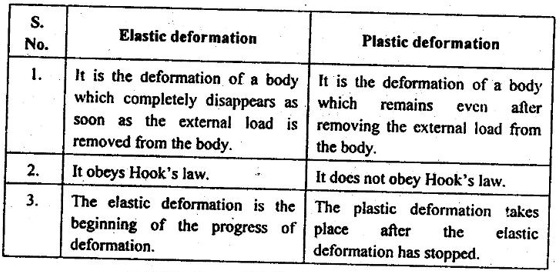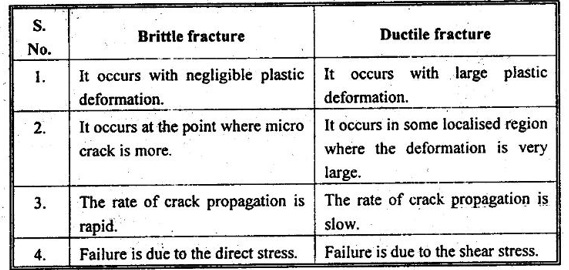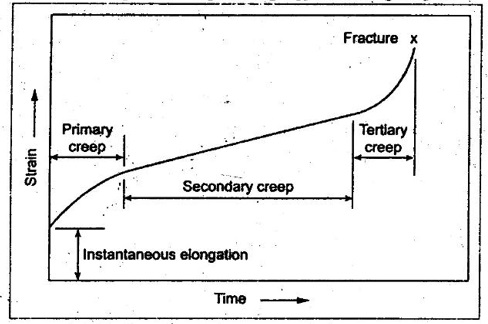1. What is meant by mechanical properties of materials?
Mechanical properties are those characteristics of material that describe its behaviour under the action of external forces.
2. Distinguish between elasticity and plasticity.
✔ Elasticity is the property of a material by virtue of which it is able to retain its original shape and size after the removal of the load.
✔ Plasticity is the property of a material by virtue of which a permanent deformation (without fracture) takes place, whenever it is subjected to the action of external forces.
3. Differentiate between ductility and malleability.
✔ Ductility is the property of a material by virtue of which it can be drawn into wires before rupture takes place.
✔ Malleability is the property of a material by virtue of which it can withstand deformation under compression without rupture.
4. Define the terms brittleness and hardness.
✔ Brittleness is the property of a material by virtue of which it can withstand deformation under compression without rupture.
✔ Hardness is the property of a material by virtue of which it is able to resist abrasion, indentation (or penetration), machining, and scratching.
5. What do you mean by toughness and stiffness?
✔ Toughness is the property of a material by virtue of which it can absorb maximum energy before fracture takes place.
✔ Stiffness is the property of a material by virtue of which it resists deformation.
6. List any four technological properties of metals.
1. Machinability,
2. Castability,
3. Weldability, and
4. Formability or workability.
7. What are the factors affecting mechanical properties?
1. Grain size,
2. Heat treatment,
3. Atmospheric exposure, and
4. Low and high temperatures.
8. What is the effect of the grain size on the mechanical properties of the materials?
✔ The materials having smaller grains (i.e., fine grained structure) have high yield strength, high tensile strength, and more hardness. Also fine grain results in better resistance to cracking and better surface finish.
✔ The materials having larger grains (i.e., coarse grained structure), exhibit better workability, hardenability, forgeability and creep resistance. But coarse grains result in poor surface finish, less tough and have greater tendency to cause distortion.
9. What is the effect of heat treatment on the mechanical properties of the materials?
The heat treatment improves mechanical properties like tensile strength, toughness, hardness, ductility, shock resistance and resistance to corrosion. It also improves workability, forgeability and machinability of metals.
10. Distinguish between elastic and plastic deformation of a solid.

11. Define the terms slip and twinning.
✔ Slip may be defined as the sliding of blocks of the crystal over one another along definite crystallographic planes called slip planes.
✔ Twinning is the process in which the atoms in a part of a crystal subjected to stress, rearrange themselves so that one part of the crystal becomes a mirror image of the other part.
12. State the Schmid's law.
The stress required at a given temperature to initiate slip in a pure and perfect single crystal, for a material is constant. This is known as Schmid's law.
13. What are the causes of twins?
1. Mechanical twins: Twins that are produced by mechanical deformation are called mechanical twins.
2. Annealing twins: Twins that are produced by annealing are called annealing twins.
14. What is meant by fracture?
Fracture is the mechanical failure of the material which will produce the separation or fragmentation of a solid into two or more parts under the action of stresses.
15. List the different types of fracture in a material.
1. Brittle fracture,
2. Ductile fracture,
3. Fatigue fracture, and
4. Creep fracture.
16. What is brittle fracture?
A brittle fracture may be defined as a fracture which takes place by the rapid propagation of crack with a negligible deformation.
17. What is ductile fracture?
Ductile fracture may be defined as the fracture which takes place by a slow propagation of crack with appreciable plastic deformation.
18. Distinguish between brittle fracture and ductile fracture.

19. How can you prevent the ductile fracture?
In order to prevent the ductile fracture, the material should have the following characteristics:
✔ The material should have fine grains.
✔ It should have higher hardness value.
✔ It should have higher Young's modulus and cohesive energy.
✔ It should not have any defects/dislocations.
20. What is meant by fatigue fracture?
A fatigue fracture is defined as the fracture which takes place under repeatedly applied fatigue stresses.
21. What is S-N diagram? What is the significance of it?
The S-N diagram is a graph obtained by plotting the number of cycles of stress reversals (N) required to cause fracture against the applied stress level (S). Using S-N diagram, the fatigue life of a material can be determined.
22. What are the factors affecting fatigue strength?
1. Fatigue strength is influenced by many factors such as chemical composition, grain size, and amount of cold working.
2. Fatigue strength is high at low temperatures and gradually decreases with rise in temperature.
3. Environmental effects such as corrosion of the product by moisture decreases the fatigue strength.
4. The design of the product also influences the fatigue strength.
23. How can you prevent the fatigue fracture?
The following methods can be adopted to prevent the fatigue failure.
1. Use of good design to avoid stress concentration by eliminating sharp recesses and severe stress raisers.
2. Control of the surface finish by avoiding damage to surface machining, punching, stamping, shearing, etc.
3. Reduction of corrosion environmental effects by surface heat treatments like polishings, coatings, carburizing, nitriding, etc.
4. The material should have fine grain structure and also it should be free from residual stresses and dislocations.
24. What is meant by creep fracture?
The creep is defined as the property of a material by virtue of which it deforms continuously under a steady load.
25. Sketch a creep curve explaining different stages of it.

26. What are the factors affecting creep?
1. Grain
2. Thermal stability of the micro-structure
3. Chemical reactions
4. Prior strain
27. How can you prevent the creep fractures?
The following methods can be adopted to prevent the creep failure.
1. Use of coarse grained materials will avoid creep fracture.
2. Strain hardening can be done to avoid creep fracture.
3. The material should be free from any residual stresses and dislocations.
4. Precipitation-hardened alloys can be used to avoid creep fracture.
28. Differentiate between destructive and non-destructive tests.
✔ In destructive type of testing, the component or specimen to be tested is destroyed and cannot be reused.
✔ In non-destructive type of testing, the component or specimen to be tested is not destroyed and can be reused after the test.
29. List some important destructive tests carried out on a material.
(i) Tensile test,
(ii) Impact test,
(iii) Bend test,
(iv) Fatigue test,
(v) Torsion test, and
(vi) Creep test.
30. List the main parameters which may be determined in a tensile test.
(i) Limit of proportionality,
(ii) Yield point or yield strength,
(iii) Maximum tensile strength,
(iv) Breaking strength,
(v) Percentage elongation,
(vi) Percentage reduction in area, and
(vii) Modulus of elasticity.
31. How does the Rockwell test differ from that of the others?
The principle of the Rockwell test differs from that of the others in that the depth of the impression is related to the hardness rather than the diameter or diagonal of the impression.
32. Why must Rockwell test numbers always include a letter, such as A, B, or C?
The Rockwell scales such A, B, or C are used to denote the type and size of the indenter used and the total indenting load to be applied.
33. What is the difference between Izod and Charpy impact testing methods?
✓ Based on the types of specimen used on impact testing machine, the impact tests can be classified into: 1. Izod test, and 2. Charpy test.
✓ Izod test uses a cantilever specimen of size 75 mm × 10 mm × 10 mm. The Charpy test uses a simply-supported test specimen of size 55 mm × 10 mm × 10 mm.
34. Define the term notch sensitivity.
The notch sensitivity refers to the tendency of some normal ductile materials to behave like brittle materials in the presence of notches.
No comments:
Post a Comment